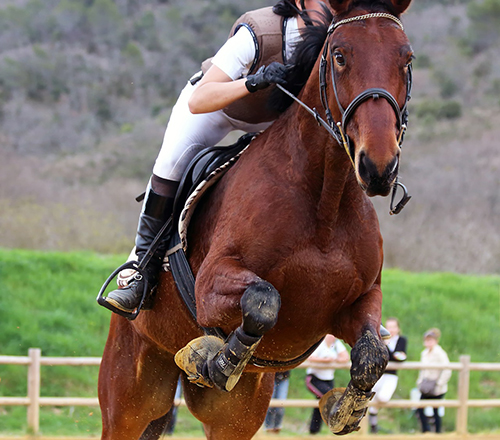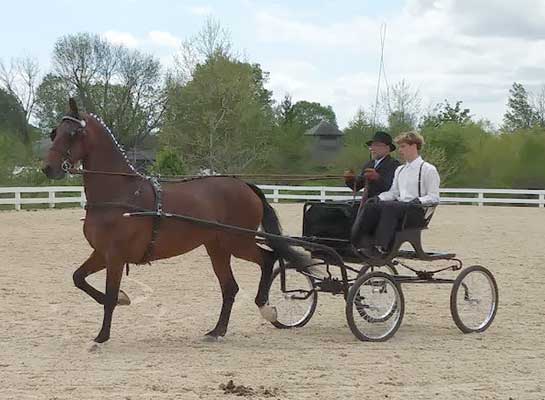
Understanding horse arthritis treatment and horse joint health
Thoroughbred mare, Tiz Cha Cha, never traveled balanced to the left. When she would collect in dressage or frame over a jump, she would become aggressive with ears pinned, relentlessly throw her head or rear up dangerously. Her behavior was chalked up to being a “hot” off-the-track Thoroughbred; however, a series of X-rays revealed what the human eye could not see -- a C1 fracture of the vertebrae, nearest the poll, causing her significant pain from bone-on-bone contact and arthritis.
What is equine osteoarthritis or degenerative joint disease?
Equine degenerative joint disease (DJD) is often referred to as equine osteoarthritis (OA). This chronic disease causes degeneration of the joints and results in pain, inflammation and reduced flexibility. Any joint in a horse’s body can be affected, and all horses regardless of age, breed or discipline can be impacted. It is estimated that OA is responsible for up to 60 percent of all lameness in horses.
Do different equine sports affect specific joints?
Although any horse in any discipline can be affected by OA, there are common themes and joint problems that occur in the varying equine sports. Such as for cutting and reining horses, who have greater impact on their hocks and stifles causing them to have heightened OA risk to these joints. Additionally, hunter jumpers are more likely to have front limb lameness in the coffin or fetlock joints. Any joint that is more significantly used on a horse increases its likelihood for developing OA.

What causes arthritis in horses?
- Trauma to the joint
- Conformation
- Age
- Improper shoeing
What are the signs of arthritis in horses?
- Limping or lameness in single or multiple joints
- Warm-to-the-touch, swollen or painful joints
- Reluctance or difficulty standing, walking, trotting or cantering
- Stiffness or decreased movement of joints
What can I do if I think my horse has arthritis?
If you suspect your horse is suffering from joint pain, request an examination from your veterinarian. Your veterinarian can perform a lameness evaluation, during which he or she may also recommend other diagnostics for a clear diagnosis. Should OA be diagnosed, ask for information about treatment for the pain and inflammation associated with osteoarthritis.
How will my veterinarian make a diagnosis of OA in my horse?
In addition to observing your horse during a routine lameness examination, your veterinarian has several diagnostic tools available for determining whether your horse has arthritis, including:
- Radiographs
- Fluoroscopy
- Nuclear scintigraphy
- CT
- MRI
- Nerve and joint blocks
- Ultrasound
- Thermography
Can equine osteoarthritis be cured?
While there is, unfortunately, no definitive cure for OA in horses, the pain and inflammation associated with equine osteoarthritis can be treated.
What are horse arthritis treatment options?
Treatment for equine OA focuses on alleviating pain and inflammation in the joint, allowing horses to have improved mobility. Ask your veterinarian for more information about treating the pain and inflammation associated with equine osteoarthritis. Your veterinarian may recommend prescription medication for your horse, such as Equioxx, Adequan i.m., Legend or Surpass Topical.
How can joint health problems in horses be prevented?
- Incorporate horse arthritis supplements to help maintain joints and cartilage.
- Prioritize hoof care and keep horses on a regular trim schedule. Learn more about horse hoof care from a lifelong horse farrier.
- Keep horses at optimum weight and avoid obesity, which stresses the joints.
- Offer quality nutrition for strong bones and healthy cartilage.
- Ride on softer footing and limit work on hard surfaces.
- Look to veterinarian-founded, veterinarian-owned Valley Vet Supply for products that support horse joint health.
About Valley Vet Supply
Valley Vet Supply was founded in 1985 by veterinarians to provide customers with the very best animal health solutions. Building on over half a century experience in veterinary medicine, Valley Vet Supply serves equine, pet and livestock owners with more than 23,000 products and medications hand-selected by Valley Vet Supply founding veterinarians and their professional staff. With an in-house pharmacy that is licensed in all 50 states, and verified through the National Association of Boards of Pharmacy (NABP), Valley Vet Supply is the dedicated source for all things horse, livestock and pet.
You can find Valley Vet on our Veterinarians page in the section on Veterinarian Supplies.
Read more informative articles in our section on Health & Education.


































